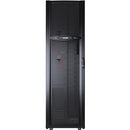Description
APC by Schneider Electric 175kVA PDU
Experience scalable, efficient 3-phase power distribution with the APC by Schneider Electric 175kVA PDU. This modular power distribution solution is engineered for modern data centers that demand agility, reliability, and long-term cost efficiency. By embracing a Modular Power Distribution approach, it eliminates the need to perfectly forecast every future requirement, enabling you to adapt quickly to changing workloads, peak demands, and expanding rack densities. Built to support mission-critical operations, the 175kVA PDU delivers consistent power delivery, improved thermal management, and streamlined maintenance, all while helping you optimize space, energy use, and total cost of ownership.
- Modular design for scalable power distribution: A modular architecture lets you add or rearrange power modules as your data center evolves, so you don’t over-provision or under-allocate capacity. This agility keeps your PDU aligned with current needs and future growth.
- Three-phase power distribution for demanding workloads: Specifically engineered for high-density, multi-rack environments, the 175kVA PDU supports balanced loads across three phases to minimize voltage fluctuations and maximize equipment uptime.
- Configurable bays and hot-swappable components: Configure output quickly to match changing equipment footprints. Hot-swappable modules reduce downtime during maintenance or expansion, keeping critical services online.
- Energy efficiency and reliability at scale: Advanced monitoring and intelligent power management reduce energy waste, lower cooling requirements, and improve overall data center reliability through precise load balancing and proactive fault detection.
- Integrated monitoring and EcoStruxure readiness: Seamless visibility with remote monitoring and control capabilities, enabling proactive management of power quality, occupancy, and performance within Schneider Electric’s EcoStruxure ecosystem.
Technical Details of APC by Schneider Electric 175kVA PDU
- Model: APC by Schneider Electric 175kVA Modular PDU
- Topology: Modular three-phase power distribution designed for data centers and high-density cabinets
- Input configuration: Three-phase input with configurable voltage options to suit regional electrical standards
- Output configuration: Configurable bays and outlet assemblies to match rack layouts and equipment footprints
- Protection features: Overcurrent protection, short-circuit isolation, and fault-tolerant options to safeguard critical loads
- Modularity: Hot-swappable power modules that enable scalable expansion without system downtime
- Efficiency: Energy-conscious design minimizes power loss and supports thermal management goals
- Monitoring and control: Built-in sensors and remote monitoring compatibility with EcoStruxure for real-time insight
- Installation flexibility: Suitability for floor-mounted or cabinet-integrated deployments with versatile mounting options
How to install APC by Schneider Electric 175kVA PDU
Installing the 175kVA PDU begins with defining your data center’s power architecture and identifying the optimal placement within your racks or cabinet rows. Start by verifying the input voltage, phase configuration, and electrical clearance requirements to ensure safe, compliant installation. Secure the PDU to the chosen mounting surface or rack system, making sure there is adequate space for airflow, cable management, and access for maintenance.
Next, connect the three-phase input power following the manufacturer’s wiring diagrams. If you plan to use modular bays, install the base module first and then insert additional hot-swappable modules as needed. After physically wiring, install any necessary outlet assemblies or configurable bays to align with your equipment footprint and power distribution plan.
Perform system-level checks to confirm proper grounding, continuity, and insulation. Power up the PDU only after confirming all connections are secure and compliant with local electrical codes. Use the built-in monitoring features or EcoStruxure-compatible software to verify real-time readings for voltage, current, and load balance across all phases. Calibrate any remotely accessible sensors and set alert thresholds to align with your service levels and maintenance windows.
Finally, document the configuration, including module serial numbers, bay positions, and monitoring endpoints. Establish a routine for ongoing monitoring, periodic testing, and scheduled maintenance to sustain peak performance and minimize unexpected downtime. Regular reviews of load distribution and energy usage will help you optimize efficiency and extend the life of both the PDU and connected equipment.
Frequently asked questions
What is the APC 175kVA PDU best used for?
The 175kVA PDU is ideal for data centers, high-density server rooms, and compute clusters where scalable, reliable three-phase power distribution is essential. Its modular design supports future expansion without complete system replacement, making it a strong choice for evolving IT environments.
How does modularity benefit data center operations?
Modularity lets you add or rearrange power modules as demand grows, reducing capital expenditure on unnecessary capacity and enabling faster deployment of new racks or equipment. It also simplifies maintenance by isolating issues to specific modules, minimizing downtime and risk.
Can I integrate the 175kVA PDU with EcoStruxure?
Yes. The PDU is designed for seamless integration with Schneider Electric EcoStruxure, providing advanced analytics, remote monitoring, and centralized control. This integration enables proactive power management, alerts, and reports that support data-driven capacity planning.
Is this PDU suitable for retrofit into existing data centers?
Absolutely. Its modular bays and flexible configurations support retrofit projects where existing infrastructure must accommodate changing workloads without a full redesign.
What maintenance and support options are available?
Schneider Electric offers comprehensive maintenance programs, spare-part availability, and remote diagnostic services to ensure uptime. Regular software updates and sensor calibration help sustain accuracy and performance over time.
Customer reviews
Showing - Of Reviews


